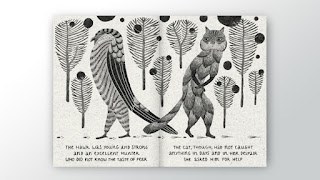Germany's Rotopol strikes again with another beautiful comic/art object, with Rita Fürstenau's comic In Winter. It's a fable of sorts, rendered in a stark gray wash on sturdy cream paper. There's a dark grittiness to this winter tale that's about cold hearts and bitter reactions. The story is also a loop that's all about cycles and events coming around again and again. Fürstenau's line is gorgeous and stark as she depicts a beautiful hawk and a poor, starving cat. The cat is taken by Death, who pities her, and turns her into a beautiful owl. The hawk falls in love with the owl, who tolerates the attention until one night she claws out his eyes and leaves him. The wind became the lonely owl's companion, but it was relentlessly insistent and drained her. Finally, she came upon a cat in the forest and her heart melted, reminding her of the friendship that she had needed in the first place.
This is a book about perpetuating the cycle of abuse. The hawk is cruel to the cat, who becomes cruel to the hawk when transformed into an owl. That cruelty leads others to shun the owl. Becoming friends with the wind is an elegant metaphor for falling in love with an idea, of adoring ephemera instead of substance. It may be exhilarating for a while, but it is draining instead of sustaining. There's no give and take, no opportunity for mercy or grace. There's just the wind and acceleration. Fürstenau makes frequent use of visual metanyms in the story, as the feather takes the place of the hawk, Death is represented by the inky void, an empty nest stands in for the owl that appears later, and tracks stand in place of the new cat and the owl. This is her way of establishing the elusive and ephemeral qualities of intimacy; we can't quite grasp it in the moment and can only remember flashes of it afterward.
That's further established by the way she arranged her figures on the page. They face away from each other when they even do appear on the page, until the very end when the owl allows herself to be vulnerable to the new cat she meets. It takes place in winter because it's the season of death, when every animal is at their most vulnerable but also in the greatest need of help. Death is everywhere, but it's not a malevolent force. It's simply part of the natural cycle of things, but even Death is merciful here, embracing the poor cat completely and transforming her. It accepts the cat , visually absorbing and transforming it through that mercy and intimacy. It isn't until almost complete ego loss for the cat/owl that she can finally allow herself to become vulnerable again, seeing herself in the cat and allowing the cat to see her. If patterns and cycles repeat in this comic, Fürstenau argues that we will always have opportunities to change and break cycles as well as succumb to that pressure.
Wednesday, November 21, 2018
Subscribe to:
Post Comments (Atom)






No comments:
Post a Comment